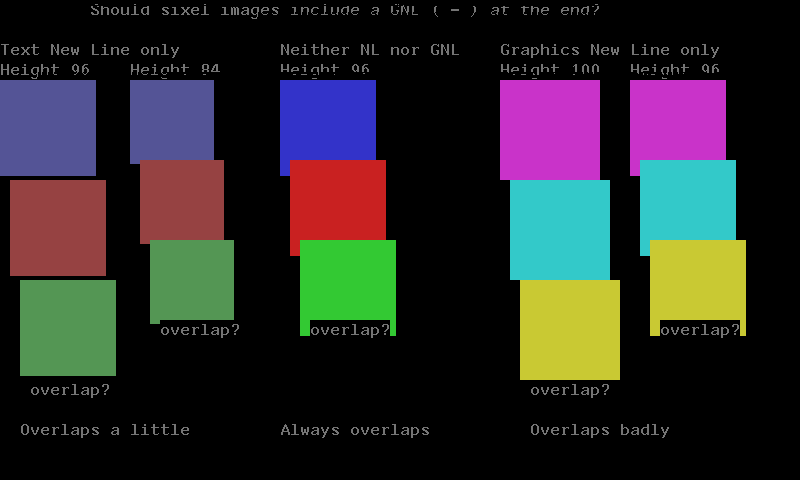This is the page where I'll record hardware/firmware bugs as I come across them.
j4james's bounce program, animation.sh, shows red turning black and
white turning yellow when the ball "moves" up and down. (Animation is
done by panning the screen up and down using CSI Pn S and CSI Pn T).
See Issue #11 in which @j4james has figured out at what aspect ratios extra lines of scrolling are unnecessarily added. He has this to say:
if you're about to write out a sixel line that isn't going to fit, you calculate the number of rows required using
(imageHeight/lineHeight)+1rather thanceil(imageHeight/lineHeight)(which would have been more "correct"). This results in an extra row when the image height is a multiple of 20 (the line height).
But note that this can only occur when the aspect ratio is 4:1 or above. At lower aspect ratios the sixel height is such that it would never be overflowing if it was also an exact multiple of the line height.
@j4james may correct me on this, but I believe it is a glitch in the VT340 hardware that for certain heights of sixel images the text cursor is moved so that it overlaps not the final line of sixels but the row above it.
Normally, one needs only a single text newline (\n) to go to the
next free line of text after sending a sixel image, but for those
particular heights, one would need two.
This bug occurs if (h-1)%6 > (h-1)%20, for a sixel image of height h. Looking at all possible heights on the VT340 (from 1 to 480), the entire list of buggy heights is:
21 22 23 24 41 42 81 82 83 84 101 102 141 142 143 144 161 162 201 202 203 204 221 222 261 262 263 264 281 282 321 322 323 324 341 342 381 382 383 384 401 402 441 442 443 444 461 462
Please see sixeltests/textcursor.sh which tests text overlap when using GNL (Graphics New Line) and NL (New Line). Output on a VT340 looks like this:
Other than checking each image's height to see if it is problematic, what other solutions are there? As luck would have it, many programmers may never run into this problem since scaling an image so its height fits a certain number of text rows — which is useful thing to do anyway — means the bug would never be triggered.
A text row is 20 pixels in height, but actually any image height which is a multiple of ten (which is common) also works. In fact, although less frequently seen, any multiple of 5 avoids the glitch.
The final digit in the table of buggy heights shows how many pixels would be shaved off the bottom of the image if the glitch had occurred and only a single newline was used before printing text. The maximum is 4, but that occurs less often than one might expect. Counting the possibilities, we get:
| Pixels shaved | Count | Probability (given glitch has occurred) |
|---|---|---|
| 1 | 16 | ⅓ |
| 2 | 16 | ⅓ |
| 3 | 8 | ⅙ |
| 4 | 8 | ⅙ |
When the glitch occurs, two thirds of the time only 1 or 2 lines of pixels would be overwritten by text. But, the glitch only occurs on 48 out of 480 possible image sizes. Adding the other 432 possibilities into the table gives:
| Pixels shaved | Count | Probability |
|---|---|---|
| 0 | 432 | 90% |
| 1 | 16 | 3.33% |
| 2 | 16 | 3.33% |
| 3 | 8 | 1.66% |
| 4 | 8 | 1.66% |
So, the vast majority of the time, there will be no problem and when there is a problem, it will likely be only 1 or 2 lines of pixels cut off. Whether that matters or not depends on the application being developed.
After entering Tek mode (using CSI ? 38 h) and then exiting it (CSI ? 38 l), Auto Wrap Mode will be turned off. The workaround is to just
turn it back on again with CSI ? 7 h.
Here is a place for me to stash odd behavior that I thought was a bug but was actually by design.
I had thought this was an annoying bug but @j4james set me straight. I had expected the final graphics new line (DECGNL) in a sixel image would ensure that my text cursor would start on the next available line of text. It only does some of the time since DECGNL is six pixels high and text is 20 pixels. A lot of the time, the next words printed overlap with the bottom of the image. (What good could that possibly be? Read on to find out!)
I had attempted to add a standard new line after the image, but that simply shifted the problem so that occasionally there would be two blank lines.
@j4james pointed out that the solution is to not send the final DECGNL in the image. Even better, @j4james points out, if you decide to not send the text new line, you can show a full screen image, all the way to the bottom right corner without scrolling.
Since you are guaranteed to be on a line with graphics, if you send a
text new line afterward, it will be on the next appropriate line, no
extra blank line.
[EDIT: I MISUNDERSTOOD AGAIN. THE PREVIOUS PARAGRAPH IS NOT TRUE].
Please see sixeltests/textcursor.sh which shows how various methods overlap depending upon the height of the sixel image sent. Sending a newline seems to overlap the least, but does still have problems.
To do: @j4james said something CUR CUD (cursor down) is correct.
